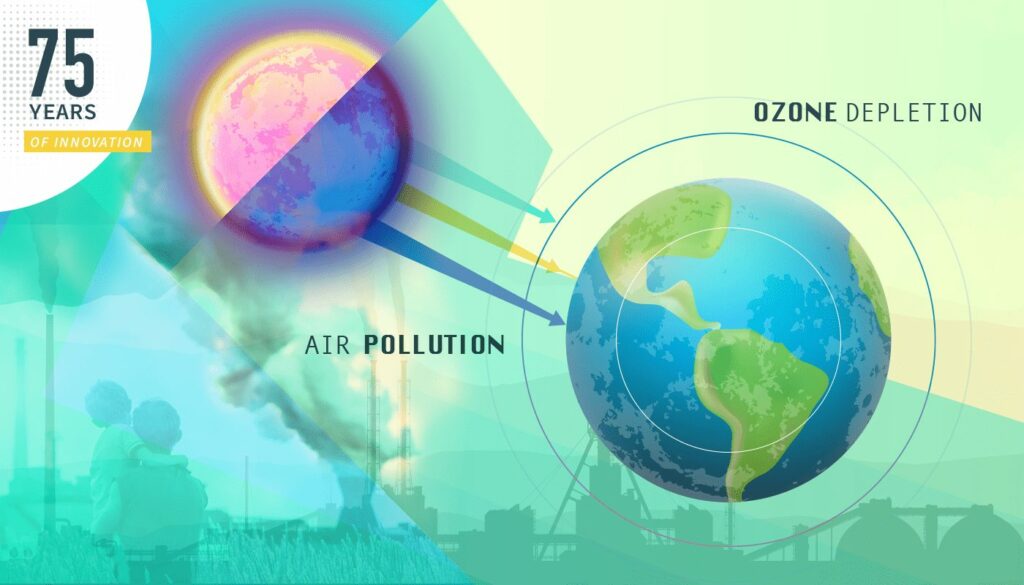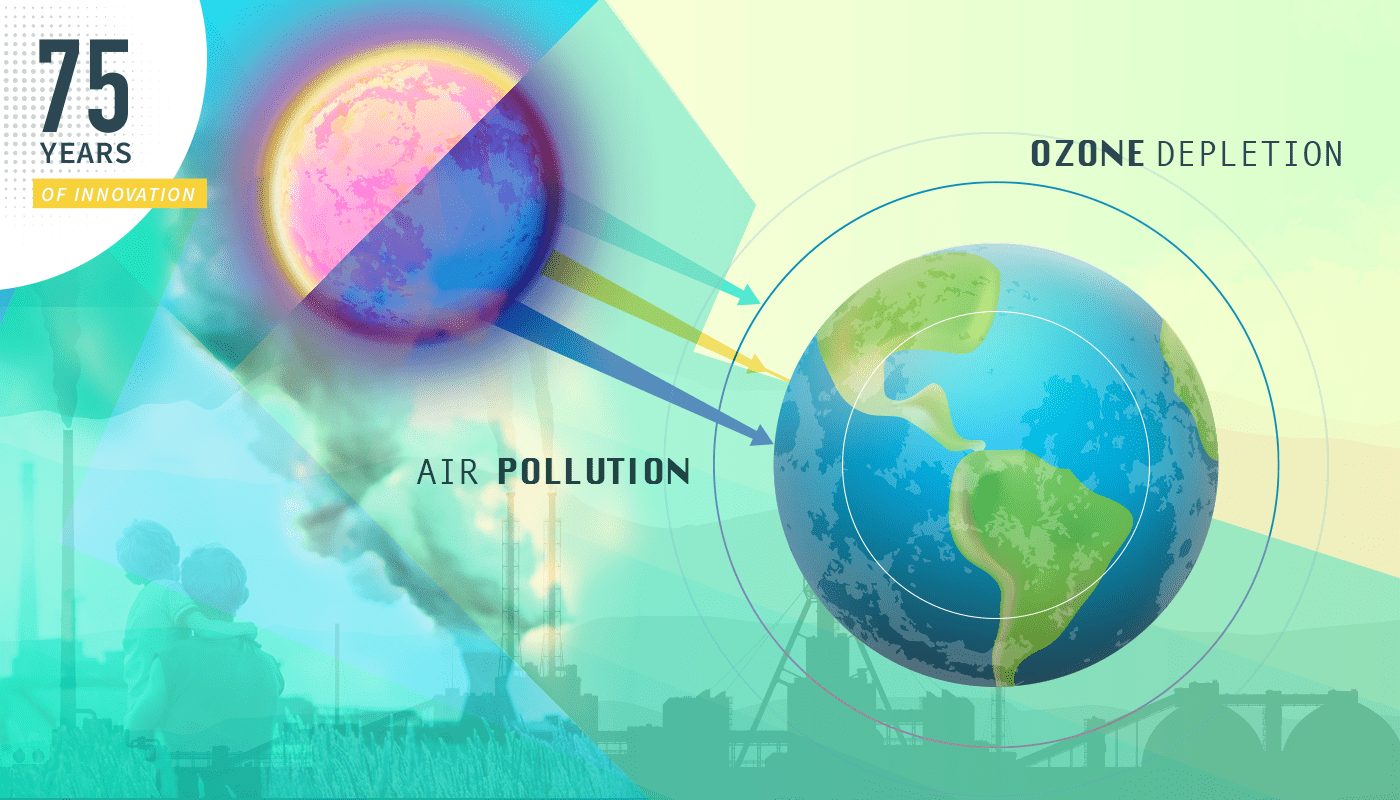The 75 Years of Innovation series highlights the groundbreaking innovations spanning from SRI’s founding in 1946 to today. Each week, SRI will release an innovation, leading up to its 75th anniversary in November 2021.

Tests and processes that develop our understanding of the impact of pollution on the planet and how to deal with it
Cleaning up our act: How SRI has helped to reduce air pollution
SRI International has been researching the impacts of air pollution on our health since the 1940s. SRI has used this research to help develop new ways of mitigating pollution and cleaning up our planet. Here is a brief history of SRI’s activities to help the world fight this most human of creations, air pollution.
SRI International fighting pollution: The research
SRI has been studying the impact of environmental pollutants on human health for decades. In 1947, the institute began researching the effects of smog on human health. At the time, smog was a serious killer in cities including Los Angeles and London. For example, the 1952 “Great Smog of London” is estimated to have killed up to 12,000 people. The results of SRI and other researchers’ work were published in the 1956 Air Pollution Handbook, edited by SRI researchers. This book is still used today.
In the 1970s and 1980s, SRI conducted a series of studies modeling the pathogenesis of human respiratory diseases such as emphysema and COPD. The studies provided evidence that these diseases were caused by common air contaminants in industrial and automobile exhaust and tobacco smoke. The results were fundamental to national and international efforts to set allowable limits of nitrogen oxide and ozone contents in industrial exhausts and define indoor air-quality standards.
In 1980, SRI, alongside the US Environmental Protection Agency (EPA), compiled a report covering several research studies. The report “Human Exposure to Atmospheric Concentrations of Selected Chemicals: SRI International (Menlo Park, CA)” looked at the effect of four pollutants on human respiration, providing essential data for anyone wishing to tackle pollution.
By the 1980s, ozone depletion had become a severe threat. Evidence from ground-based and satellite measurements revealed a picture of a thinning ozone layer over the Antarctic. SRI contributed to vital research showing how certain chlorofluorocarbons (CFCs) contribute to the depletion of stratospheric ozone, which is essential to protect humans and plants from harmful ultraviolet rays. At that time, the National Oceanic & Atmospheric Administration (NOAA) postulated that a reaction step in ozone depletion involved the heterogeneous reaction between climate gases and particles. Margaret Tolbert, a postdoctoral researcher at SRI International, was a member of a team of researchers who tested the NOAA’s hypothesis. The team showed evidence that heterogeneous reactions on ice converted inert chlorine into more active forms. The team went on to demonstrate how anthropogenic chlorine in the stratosphere came from chlorofluorocarbons, which reacted in polar stratospheric clouds to release active chlorine that destroyed ozone. The team shared their result in a landmark paper published in 1987 by the American Association for the Advancement of Science (AAAS) entitled “Reaction of Chlorine Nitrate with Hydrogen Chloride and Water at Antarctic Stratospheric Temperatures.”
A clean future by capturing carbon
Research is the basis for innovation. SRI’s research often moves to the next level of development, and in doing so, creates important processes and technologies to help make the future of our planet greener and cleaner. One such development is the Mixed Salt Process (MSP) for carbon capture.
MSP is a vital technology in helping to meet the 2050 climate and net-zero emissions targets. Manish Kothari, president of SRI International, describes MSP; “Our process (MSP) has the benefits of a low manufacturing carbon footprint, reduced energy consumption and greater efficiency.” MSP combines potassium and ammonia salt solutions to capture CO2 emissions from coal-fired power plants while improving efficiency by reducing energy consumption.
SRI cleaning up humans’ act
SRI has been intrinsically involved in developing technologies and processes that help clean up our planet. SRI has contributed significantly to EPA regulations by expanding the general methods and protocols to test the properties of potentially harmful chemicals as they are created and transformed in the Earth’s environment.
Test methods developed by SRI use hydrolysis, photochemical reactions and sorption in soil, as well as vapor pressure and volatilization models for dispersion in air. These SRI methods have been used in EPA testing since 1982 and continue to this day.
SRI is committed to furthering the understanding of pollutants and developing solutions to help manage air pollution. In 1949, SRI International held the First National Air Pollution Symposium in Pasadena, California; this was the first of many such events. Much important research on pollution and climate change research and initial climate change legislation came out of these conferences, including the Air Pollution Control Act of 1955.
We all need to be able to breathe the fresh air of our planet, and SRI’s R&D for a cleaner environment continues today in clean materials, green technology and processes for renewable energy and energy storage.
Resources
Nasa, The effects of climate change: https://climate.nasa.gov/effects/
World Health Organization (WHO): https://www.who.int/news-room/q-a-detail/chronic-respiratory-diseases-asthma
SRI International, report into “Human Exposure to Atmospheric Concentrations of Selected Chemicals,” 1980
Proceedings of the First National Air Pollution Symposium, 1949. Leslie Silverman papers, H MS c069. Countway Library of Medicine, Center for the History of Medicine. https://id.lib.harvard.edu/ead/c/med00396c00170/catalog Accessed May 24, 2021
Air Pollution Handbook-Edited by Paul L. Magill; Francis R. Holden; and Charles Ackley. New York: McGraw-Hill Book Company (330 West 42nd St.), 1956.
AAAS, Reaction of Chlorine Nitrate with Hydrogen Chloride and Water at Antarctic Stratospheric Temperatures
BY MARGARET A. TOLBERT, MICHEL J. ROSSI, RIPUDAMAN MALHOTRA, DAVID M. GOLDEN SCIENCE 27 NOV 1987: 1258–1260



